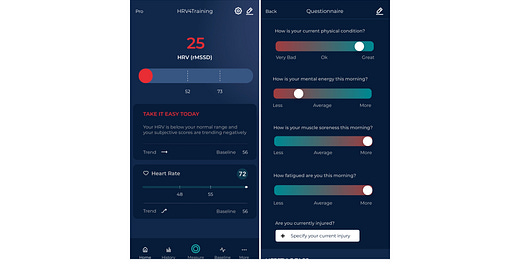Recent articles and updates [May 2024]
heart rate variability, wearables, entrepreneurship, training talk and some ramblings
hi there 👋
I hope all is well.
Here is my newsletter including articles and updates from May 2024. I hope you’ll find it useful and I would like to take the opportunity to thank you for your support.
Please feel free to comment below or in the articles should you have any questions, and I will follow up soon.
Take care!

Heart rate variability (HRV) 🫀
Absolute values of Heart Rate Variability (HRV). I often stress how HRV is, in my opinion, more useful when we look at it in relative terms, as opposed to its absolute value. I saw people obsess over their values in ways that led to dysfunctional behaviors, and I am concerned that overly focusing on our numbers, comparing them with others, etc. can be unhelpful and make things worse. I am also not a believer that everything is under our control and you just need to make this or that change for things to go well. Sure, at times, that is the case, but for many, that’s not how things work. Learn more in this blog.
Measurement position. I've talked a few times about the importance of measuring HRV while seated (or standing), as opposed to while supine (lying down). In a recent study, blood pressure changes after exercise of different intensities were missed completely while supine, and clearly visible while seated or standing: "For both standing and seated postures, the higher exercise intensity led to larger reductions in blood pressures, whereas in the supine posture, the reduction in blood pressure was unaffected by prior exercise intensity". By measuring intentionally, while seated, you can capture your body's response to exercise intensity in ways that are not possible while lying down (e.g. during sleep). Learn more, here.

Wearables ⌚️
Issues with night data and made-up scores based on sleep. In this post, we look at a few important aspects associated with measuring resting physiology and stress responses: 1) Measurement timing (morning vs night). 2) Measurement position (sitting vs standing). 3) Actual physiology (HRV) vs made-up scores (e.g. readiness). It is not my intention to pick on any brand (quite the contrary, honestly!), but it is my intention to make sure people can use physiological data effectively. In the context of training, and for daily actionability, the way to do this is really simple: HRV must be measured in the morning, and not combined with sleep data. Learn more, here.
Podcasts, Talks, and Papers 🎙️
Paper 📝 Heart Rate Variability in Professional and Semi-Professional Soccer: A Scoping Review. Our paper, an effort led by Mauro Mirto of the University of Milan, was accepted for publication in the Scandinavian Journal of Medicine and Science in Sports. The paper provides a comprehensive overview of HRV in soccer, where it is less explored than in endurance sports. More on this soon.
Webinar 🎥 for European Athletics published on their e-learning platform, which you can find here (if you have access). In this webinar, I cover heart rate variability (HRV) analysis, its physiological basis, inconsistencies in data collection protocols, metrics used, and data analysis techniques, as well as issues with the accuracy and validity of today's wearable technology.
Podcast 🎙️ Heart Rate Variability and Training: Best Practices with Marco Altini. I had a really nice chat with Martin, covering the following about heart rate variability: How robust is the science? Absolute value, health & fitness. HRV vs resting heart rate. What features to use. Three best practices: measuring accurately, at a meaningful time, and how to interpret your data. You can find it on his YouTube channel, here.
Building 🛠️
Cumulative scores: inputs, outputs, and a better way to track your response. In HRV4Training Pro, you can build your own cumulative score, based on physiological and subjective data. Here we don't build scores that are driven by your behavior (input), but we look at outputs instead. We also don't convert it to any % or made-up scale (e.g. 0-100), but show it changes with respect to your own normal range for the same set of parameters. Outputs are: how your physiology responded (heart rate, HRV) how you feel in the morning This is a key difference from what you get in terms of readiness or recovery scores in most wearables. Why is that? Learn more, here.

Training talk 🏃🏻♂️🚴
I raced the 100 km del Passatore (Strava activity here), a race I have been obsessed with for a long time (and wasn’t able to finish in my previous attempt).
I finished in 9 hours and 25 minutes, more or less in line with an ideal race scenario, ranking 69th of about 3500 runners. It was quite a day, and as I write this blog I am both tired and elated. Here, I cover the training (including a high-level overview of the past few years, as well as more details on volume, intensity, specificity, hills, heat acclimation, long runs, and takeaways) and race (what I had planned vs how I executed, difficulties and learnings in terms of pacing, fueling and hydration).
Training log. As the name says, this is simply my training diary for this year.

That’s a wrap for this month.
Thank you for reading, and see you next month.
Recent newsletters:
Marco holds a PhD cum laude in applied machine learning, a M.Sc. cum laude in computer science engineering, and a M.Sc. cum laude in human movement sciences and high-performance coaching.
He has published more than 50 papers and patents at the intersection between physiology, health, technology, and human performance.
He is co-founder of HRV4Training, advisor at Oura, guest lecturer at VU Amsterdam, and editor for IEEE Pervasive Computing Magazine. He loves running.
Social:





